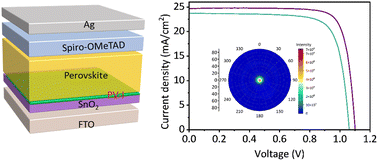Functionalized polymer modified buried interface for enhanced efficiency and stability of perovskite solar cells†
Abstract
Although great progress has been made in perovskite solar cells (PCSs), further development of PCSs is hindered by a large number of defects, nonradiative recombination, and mysterious stresses. Here, we propose a new interfacial strategy by introducing a new polymer material named povidone-iodine (PV-I) as a buffer layer. A series of studies indicate that the introduced buffer layer can form a strong chemical interaction with SnO2 and the perovskite, which can not only passivate the defects of the two functional layers but also strengthen the interfacial connection. The reduction of film defects and the enhancement of interface connection are beneficial to the extraction and transport of the carrier. In addition, the introduction of a buffer layer releases the interfacial stress. Ultimately, we achieved attractive efficiency (22.02%, 0.1 cm2) and considerable long-term stability (after aging 500 h, the target device still retains 81% of its original PCE). The excellent performance of the device indicates that this strategy can be used as an effective control method for perovskite solar cells to facilitate their commercialization.

- This article is part of the themed collection: Halide Perovskite Optoelectronics


 Please wait while we load your content...
Please wait while we load your content...